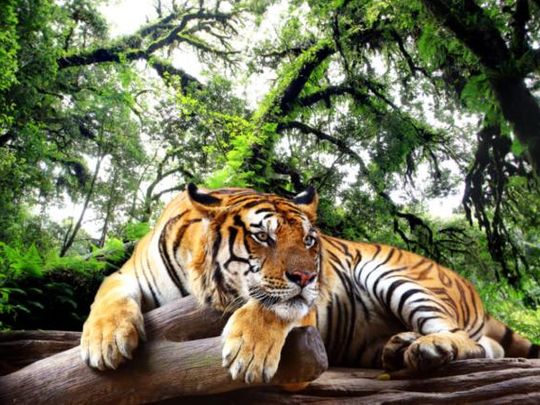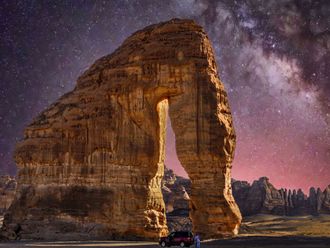
Yedaguri Rajeev Reddy has a repertoire of tiger tales that he’s collected over the years. “A while back I was on the jungle trail for an evening safari, when all of a sudden there was streak of muscle flying across the jeep we were travelling in, almost grazing our caps!” he says, his small eyes getting bigger as he recalls the frightening experience. “It was chasing a deer that we hadn’t spotted, and the next thing, the deer was in its jaws. We had no idea how close we had been to danger.”
The 57-year-old chairman and managing director of global travel company Country Club India could regale you with tales about the magnificent beasts from dawn to dusk, if you could pin down this globe-trotting tycoon, that is. We were lucky enough to have his undivided attention for a few days as his guest at The Country Club Bush Betta Resort in Bandipur, Karnataka, in the south of the country recently.
We were shown an impressive video recording of a tiger attacking a herd of gaur (Indian bison) right in front of one of the company’s safari groups a few weeks previously.
While tigers are notoriously shy, Rajeev promised to deliver us the goods on our trip. “I’ve always managed to spot one on all my safaris,” he told us. But his son, Varun, who is joint managing director of the company, cautioned he had never spotted a tiger in all the years he’d been on safaris in neighbouring Bandipur National Tiger Reserve, which is said to host a hundred of the endangered beasts.
According to the latest tiger census report dated 2011 by the National Tiger Conservation Authority, the current tiger population is estimated at just 1,706 from 17 Indian states.
But I am getting ahead of myself. The journey to get to this resort is quite an adventure in itself. We were told to expect dry heat in the middle of August. Surprisingly, we were greeted by cool balmy and dark skies in the early morning.
“Expect a shower any moment,” said the representative who met us at Bengaluru international airport. Sure enough, it was drizzling by the time we were in the minibus ready to take us on the 226km drive to Bandipur. There was to be no respite after the overnight flight from Dubai; we got straight on to the road and headed south-west to Karnataka’s second-largest city, Mysore. When we reached there after a four-hour drive we broke for breakfast. Another hour-and-a-half on a narrow strip of road surrounded on both sides by dense undergrowth and we were in Bandipur. Then a quick turn on to a mud path and suddenly the Country Club Bush Betta Resort loomed before us as if conjured up by the wave of a wand.
We were unprepared for the welcome committee, for that’s what it appeared to be – more than a dozen hotel staff armed with flower garlands. A local band playing indigenous percussion and wind instruments performed merrily, rising into a frenzied crescendo as we got off the bus.
A few women wearing Thali necklaces – the sacred symbol of marriage for Hindu women – and carrying a mixture of auspicious turmeric and sindoor (vermilion) lit a lamp and bade us a traditional welcome, anointing our foreheads with the paste.
Then from the crowd Rajeev and Varun emerged to welcome us with garlands. When Rajeev learnt that we were there for only a day-and-a-half, he was crestfallen.
“What’s this, yaar [friend]? You should stay here at least for four days to allow us to show you our hospitality!” he exclaimed.
The resort is deliberately located on the borders of the National Park so guests can enjoy the wildlife and woodland along with other activities such as trekking, photography, bird-watching and cycling.
But we had one thing on our minds – a safari. A whiteboard in the lobby-cum-games room lists the day’s sightings in a neat tabular format – a leopard, elephants and a sloth bear were spotted yesterday. We hope to see more; the ultimate, the tiger! Any wildlife expert will tell you that rains are not conducive to wildlife spotting and master tracker-cum-resort manager Sanjay Srikantan warned us it would be highly unlikely we’d spot a tiger with the weather as it was.
After a sumptuous lunch at the lavish buffet we were off on the much-anticipated safari.
Our group of 15 journalists were told in no uncertain terms not to get out of the closed bus at any cost. If that warning was not enough to scare us, as we approached the nature reserve a signpost on the highway read: “Caution: Elephant Zone. Do Not Stop. We shall not be responsible for attacks by elephants”.
That sign is an indication of the positive conservation progress made by the Bandipur National Park since its inception. Throughout the 18th and 19th centuries, Bandipur was a hunting ground for the maharajas of Mysore. The kings and their guests would indulge in shikaar (the royal hunt), in pursuit of hunting trophies to display in their dining halls. Now, however, it has been designated an elephant corridor and the roads from Bandipur to Ooty, (the erstwhile summer destination for British tourist in the Nilgiri hills in Tamil Nadu) are closed from 9pm to 9am to allow free movement of the wild elephants.
Also, since Bandipur became a protected area under the Project Tiger scheme in 1973, tourists can move only within an earmarked zone, on guided safaris. The only shooting that happens now is with cameras – and without a flash, at that. Beyond this small zone, the vast jungle belongs to the animals.
As we venture into the forest, we’re greeted by grazing spotted deer, a lone wild boar, langurs (monkeys), a herd of sambars (larger species of deer) and massive gaurs munching on the grass. And there are birds too – the Indian Blue Jay, jungle fowl, Indian Kingfisher, the Honey Buzzard, owls, vultures and eagles, all colourful and chatty. Plus the crowning glory of the feathered variety – peacocks strutting around, showing off their plumes.
But while we (or trekker Sanjay, actually) see fresh pugmarks (animal footprints), there are no signs of any tigers, or even elephant.
Later, we pass an abandoned shack. One of the guides tells us that it is an abandoned Special Task Force (STF) outpost. This leads to a fresh and animated discussion among the group. The STF was a security force that was set up in the 1990s to capture a notorious dacoit or outlaw, Koose Muniswamy Veerappan (known as Veerappan), who operated from this forest, smuggling sandalwood and ivory.
In October 2004, 14 years after the STF began a manhunt, Veerappan and a couple of his associates were shot and killed by STF forces. True to form, Rajeev – who started working in the area just before Veerappan was killed – has many compelling stories about the outlaw.
“The government even provided a couple of guards for me, complete with machine guns,” he tells us. “It was fine until one morning, when I got up early and I found them outside my room curled up, fast asleep, hugging their guns! I shouted ‘Veerappan!’ and they jumped out of their skins scrambling for their guns!”
Our curiosity is piqued – the fact is that we never would have been able to visit Bandipur if Veerappan was still roaming these jungles, shooting elephants and kidnapping people.
As we move on, listening to tales of Veerappan’s exploits, suddenly the driver brakes, and points silently.
A few yards away, a family of elephants are pulling leaves off trees for their dinner. The mother and father shield their baby between them. The driver inches the bus forward until we are less than 100 metres from them. The father, who has been keeping a wary eye on us, suddenly turns around, its large ears flapping in anger. But then it decides that we are harmless and the family continues grazing, though the parents slowly but surely nudge junior away from our prying eyes into the protective forest nearby.
A little later we come across an old elephant who’s too busy trying to scratch its back against a ledge to bother about us.
Swarms of deer keep moving in and out of our view. As the evening advances they become frisky, some of the younger ones jumping twice their height.
We keep exploring the park, trying different trails in our elusive search of the Holy Grail – the tiger. We keep meeting up with other safari teams, who keep shaking their heads – ‘no tiger sighting today’ is the message.
However, Sanjay is unwilling to give up. He tells the driver to follow a different track – and suddenly both of them freeze, Sanjay holding up a hand to silence us. “I saw one,” he whispers, but no matter how hard we strain our eyes, we can’t see anything. We wait with bated breath, still as statues. And then a huge paw appears from behind a bush, some 200 yards in front of us. In a flash, it strides out, before disappearing into the undergrowth again. There is a collective sigh of relief, as well as frustration, as nobody’s been able to take a picture of the huge tigress.
Sanjay urgently confers with the driver, who jerks the bus into gear, and we are off trying to get to another vantage point from where we can see the animal better. A couple of desert rally-type twists and turns and the driver brakes again just as suddenly, throwing us all forward.
After five minutes of nail-biting impatience, the tigress appears just as suddenly as it did before, nonchalantly strolling up the dirt path, again a good 100 metres ahead. We watch in awe as she moves a few paces, and then pauses, tail twitching impatiently, head cocked alertly. “She can sense us, even though she can’t possibly smell us as we are downwind,” whispers Sanjay. Sure enough, she disappears into the undergrowth.
Sanjay and the driver spring into action and try some more quick moves to get ahead of the tigress, but she’s too clever or too shy to allow us any more chances to record her for posterity.
By now it is getting dark, and we have to get out of the forest. We drive straight back, meeting many safari groups on the way, none of whom have had the good fortune of seeing the tigress. So, that’s one more entry that can go on the lobby’s whiteboard.
Back at the resort, it’s time for a bonfire, where guests gather, sing songs and generally make merry. However, the drizzle that has been intermittent is now holding steady, so there is no merry-making tonight.
The buffet dinner – Indian and continental – is hearty enough. Then begins the short trek to our cottages. The rooms are comfortable, and although there are no five-star appointments, they have a quaint rustic charm all of their own.
Guest are advised not to wander out after dark as wild animals stray into the premises occasionally, despite the electric fence that guards the resort. Deer and monkeys, their eyes shining in the dark, are known to startle many a guest who looks out of the windows.
An early morning call from an energetic rooster wakes me up. The crisp morning air is bracing, and more effective at getting me going than the hot cup of tea that follows.
The resort has arranged a trip to the nearby Mangala village for the obligatory handicraft browsing.
There is a rustic bullock cart, that used to be the only mode of transport in the region, and a local dressed in regional attire – a cotton singlet and dhoti (a white piece of cloth wrapped around the waist, and reaching down to the ankles) – who will take you on a bumpy ride if that’s your wish.
I opt out, choosing instead to climb the watchtower for a clear view across the forests into the countryside. However, it’s too windy and the nip in the air has me scuttling down quickly.
Back at the resort, Sanjay gives me some lessons in wildlife preservation. The local rangers and guides at the resorts take it upon themselves to see that the wild animals in Bandipur are cared for, he informs me.
They add salt to muddy water in the forest so that elephants can get the mineral nutrients when they smear mud from it on their bodies.
“Whenever the rainfall is poor, the thirsty animals migrate to neighbouring state of Kerala,” he says. Cameras placed at vantage points in the forest record their movements and behaviour, which allows the forest department and locals act to ensure that the animals stay in Bandipur.
The success of the Bandipur National Park is evidence that if humans are willing, the relationship between man and beast can be harmonious.
Soon it’s time to go back to Bengaluru for the return flight. We are loathe to leave. Rajeev and Varun present us with framed prints of the wild animals that Sanjay, a keen wildlife photographer, has shot over the years. Mine is a tiger in all its glory, a consolation for having missed out on a picture the day before.
As our bus reaches the Bandipur-Bengaluru road, we come across a safari jeep coming out of a trail. “Any luck?” asks our driver. A despondent shake of the head indicates that the group, in the forest for a couple of hours, has had no sighting so far. Such is jungle luck.



_resources1_16a08544951_small.jpg)








